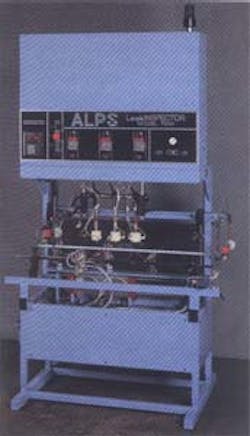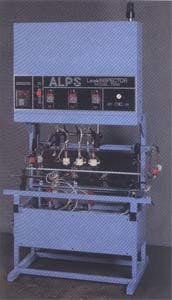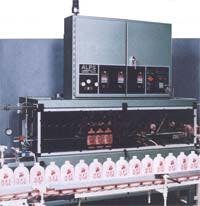High -speed, low-pressure tests check container integrity
The dominance of plastic containers for bottling all sorts of liquid products in the packaging industry continues to grow. A major reason is that plastic containers are an inexpensive commodity in a very competitive market. But if you make plastic containers, you’d better be sure that the products you deliver to your customers don’t leak—if you expect to stay in business for long.
Air Logic Power Systems, Inc., Milwaukee, builds many inspection systems, including the Model 7200 LeaklNSPECTOR to test containers for leaks right on the production line and assure that only containers that meet specifications go out the door. The Model 7200 is an in-line, lineartransfer. automatic inspection machine. Pneumatic cylinders generate all motions on the machine while a PLC fires solenoid valves that provide air-pilot signals to actuate the power valves out on the framework that control the sequence. For the light loads involved in these tests, 9/16- and 1 l/8-in. bore cylinders operating from an 80-psi nominal supply are adequate.
The PLC and the bank of solenoid valves mount in the same electrical cabinet, simplifying wiring and adding a degree of safety. Most of the steps in the sequence are event-driven and initiated by sensors, but the test itself is based on a complex time-based algorithm. Smart Test Modules (STMs), each capable of monitoring about 20 containers per minute, use advanced microprocessor functions and userfriendly software to direct the tests and provide enhanced testing data in a matter of a few seconds.
The free-standing Model 7200 mounts to the container manufacturer’s existing conveyor line so that the line passes through the test machine. A photoelectric eye counts incoming containers on the conveyor. When the number matches the number of test probes on the machine, a pneumatic stop cylinder extends to block the containers’ path. Other pneumatic cylinders on a transter assembly capture the containers front and back. then slide them downstream onto a deadplate above the conveyor. As soon as a test cycle is initiated, after releasing these containers, the transter assembly cycles back to its position at the stop cylinder.
The deadplate provides a stable base for tests that would be impossible to perform with a high level of accuracy on the moving conveyor. Machined aluminum probes with urethane seals are lowered by cylinders into the neck of each container. The standard test probes can accommodate a range of neck openings from 18 through 50 mm. Then, low-pressure (approximately 6- in. H,O) air flows into the container through a passage in the probe. A strain-gage transducer monitors pressure decay during the test period, and any container that loses pressure rapidly—indicating a hole or defective neck shape—is identified by its probe’s STM, and its position within the container group under test is recorded in the PLC. (Note that each probe has its own modular STM that can be luickly removed and replaced to keep the LeaklNSPECTOR running in the event of a problem.)
The test procedure uses low pressure for a number of reasons. First, atmospheric pressure can be the test reference. Second, the transducer accuracy only has to cover a narrow range. And finally, the containers being tested have just come out of the molding machine. They may still be warm and relatively soft. They certainly have not cured to their final stable form, so high internal pressure could actually deforrn them.
After completing the test, the group of containers on the deadplate is captured by another set of cylinders mounted on the downstream end of the transfer assembly. As the transfer assembly cycles to bring a fresh group of containers to the deadplate, the tested containers are carried simultaneously to a downstream position on the conveyor and released. A downstream photoelectric eye counts these containers as they pass, and when a number agrees with a position that the PLC knows is defective, the controller energizes a solenoid valve to extend an ejection cylinder that simply knocks the rejected container off the conveyor.
Mike Meckl, chief engineer, Air Logic Pouer Systems. Inc., described the operation of the LeaklNSPECTOR.



